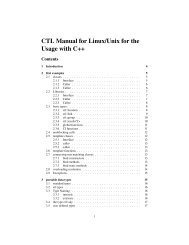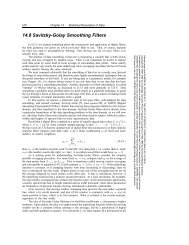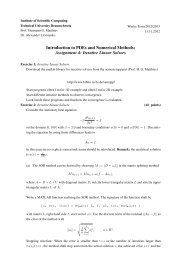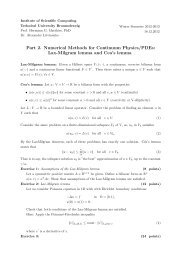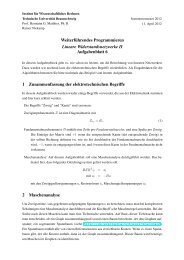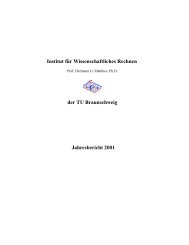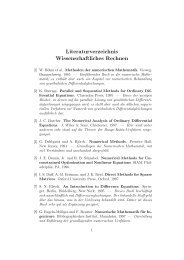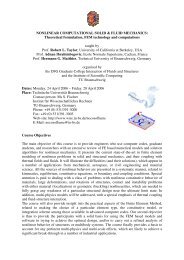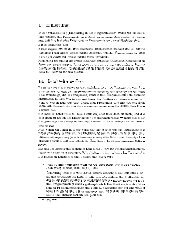Introduction to Scientific Computing - Tutorial 13: Recapitulation
Introduction to Scientific Computing - Tutorial 13: Recapitulation
Introduction to Scientific Computing - Tutorial 13: Recapitulation
Create successful ePaper yourself
Turn your PDF publications into a flip-book with our unique Google optimized e-Paper software.
<strong>Introduction</strong> <strong>to</strong> <strong>Scientific</strong> <strong>Computing</strong><br />
Tu<strong>to</strong>rial <strong>13</strong>: <strong>Recapitulation</strong><br />
Bojana Rosic, 1. Februar 20<strong>13</strong>
Relative condition number<br />
Connection between the error in input and error in output:<br />
k(x) := ∂f<br />
∂x (x) x<br />
f (x)<br />
ɛ y = ∆y<br />
y<br />
= k(x)ɛ x = k(x) ∆x<br />
x<br />
This number is important as it shows how good some system is<br />
conditioned. If the relative error in input is ɛ x then the relative error<br />
in output is k(x)ɛ x .<br />
1. Februar 20<strong>13</strong> Bojana Rosic <strong>Introduction</strong> <strong>to</strong> <strong>Scientific</strong> <strong>Computing</strong> Seite 2
Difference vs. Differential equations<br />
Difference<br />
x n+1 − x n = 2h 2 n<br />
Differential<br />
dx<br />
dt<br />
= 2t<br />
Apply Euler method<br />
x n+1 − x n = 2h 2 n<br />
Differential equations become difference when we apply numerical<br />
intergation!<br />
1. Februar 20<strong>13</strong> Bojana Rosic <strong>Introduction</strong> <strong>to</strong> <strong>Scientific</strong> <strong>Computing</strong> Seite 3
Homogeneous<br />
Difference<br />
x n+1 − x n = 0<br />
Solution form<br />
x n = Cρ n<br />
Characteristic<br />
Differential<br />
dx<br />
dt<br />
= 0<br />
Solution form<br />
x(t) = Ce ρt<br />
Characteristic<br />
ρ − 1 = 0 ρ = 0<br />
x n = C(1) n = C<br />
x = Ce 0t = C<br />
1. Februar 20<strong>13</strong> Bojana Rosic <strong>Introduction</strong> <strong>to</strong> <strong>Scientific</strong> <strong>Computing</strong> Seite 4
Homogeneous — roots<br />
Difference<br />
Differential<br />
Single roots ρ i<br />
x n = ∑ i C iρ n i<br />
Single roots ρ i<br />
x(t) = ∑ i C ie ρ it<br />
Double roots ρ 1 Double roots ρ 1<br />
x n = C 1 ρ n 1 + nC 2ρ n 1<br />
x(t) = C 1 e ρ 1t + tC 2 e ρ 1t<br />
1. Februar 20<strong>13</strong> Bojana Rosic <strong>Introduction</strong> <strong>to</strong> <strong>Scientific</strong> <strong>Computing</strong> Seite 5
Homogeneous — roots<br />
Difference<br />
Complex ρ = α ± βi<br />
Differential<br />
Complex ρ = α ± βi<br />
µ := √ α 2 + β 2<br />
tan φ = β/α<br />
x n = µ n (Acos(nφ) + iBsin(nφ))<br />
x = e αt (Acos(βt) + iBsin(βt))<br />
1. Februar 20<strong>13</strong> Bojana Rosic <strong>Introduction</strong> <strong>to</strong> <strong>Scientific</strong> <strong>Computing</strong> Seite 6
Non-homogeneous- Particular solution<br />
Difference<br />
Differential<br />
x n = x nh + x np<br />
x = x h + x p<br />
x h = Ce pt , x p = c(t)e pt<br />
variation of constant<br />
1. Februar 20<strong>13</strong> Bojana Rosic <strong>Introduction</strong> <strong>to</strong> <strong>Scientific</strong> <strong>Computing</strong> Seite 7
Stability<br />
Difference<br />
x n+1 = F(x n )<br />
Differential<br />
dx<br />
dt<br />
= f (x)<br />
x ∗ = F(x ∗ ) f (x ∗ ) = 0<br />
[λ, v] = eig DF(x ∗ ) [λ, v] = eig Df (x ∗ )<br />
(λ) n ⇒ abs (λ) 1 (real)<br />
e λt ⇒ abs (λ) 0 (real)<br />
abs (µ) 1 (complex)<br />
abs (α) 0 (complex)<br />
Remember that eigenvalues are equal <strong>to</strong> roots of charact. eq.!!<br />
1. Februar 20<strong>13</strong> Bojana Rosic <strong>Introduction</strong> <strong>to</strong> <strong>Scientific</strong> <strong>Computing</strong> Seite 8
Stability<br />
If there is just one root equal <strong>to</strong> 1 (i.e. 0) ⇒ stable but not asympt.<br />
(1) n = 1, e 0t = 1, n → ∞ & t →→ ∞<br />
If there are more than one root equal <strong>to</strong> 1( i.e. 0) ⇒ not stable<br />
c 1 (1) n +c 2 n(1) n → ∞, c 1 e 0t +c 2 te 0t → ∞, n → ∞ & t →→ ∞<br />
1. Februar 20<strong>13</strong> Bojana Rosic <strong>Introduction</strong> <strong>to</strong> <strong>Scientific</strong> <strong>Computing</strong> Seite 9
Zero-stability<br />
Test numerical method on ODE:<br />
for example Euler:<br />
write characteristic equation<br />
ẋ = 0<br />
x n+1 − x n = 0<br />
p − 1 = 0 ⇒ p = 1<br />
and find roots. Check if they are by absolute value less or equal <strong>to</strong><br />
one (THIS IS DIFFERENCE EQ.). If yes then the method is<br />
zero-stable.<br />
1. Februar 20<strong>13</strong> Bojana Rosic <strong>Introduction</strong> <strong>to</strong> <strong>Scientific</strong> <strong>Computing</strong> Seite 10
Consistency<br />
Write numerical method for ODE<br />
in a form:<br />
1<br />
h<br />
ẋ = f (t, x)<br />
k∑<br />
x n+k−i = ϕ f (t, x n+k , ..., x n , h)<br />
i=0<br />
Then find characteristic polynomial ρ(ξ) when ϕ f = 0 and its roots<br />
ξ. Then the method is consistent if<br />
and<br />
is equal <strong>to</strong> function f .<br />
ρ(1) = 0<br />
ϕ f (t, x, x, .., x, o)<br />
ρ ′ (1)<br />
1. Februar 20<strong>13</strong> Bojana Rosic <strong>Introduction</strong> <strong>to</strong> <strong>Scientific</strong> <strong>Computing</strong> Seite 11
Convergence<br />
Method is convergent if it is consistent and zero-stable.<br />
1. Februar 20<strong>13</strong> Bojana Rosic <strong>Introduction</strong> <strong>to</strong> <strong>Scientific</strong> <strong>Computing</strong> Seite 12
Numerical Integration of ODEs<br />
ẋ = f (t, x)<br />
Mid-point rule:<br />
x n+1 = x n + f (t n + h 2 , x n + h 2 f (t n, x n ))<br />
Trapezoidal rule:<br />
)<br />
x n+1 = x n + 1 2<br />
(f h (t n , x n ) + f (t n+1 , x n+1 )<br />
Read also Simpson’s rule, Lagrange interpolation<br />
1. Februar 20<strong>13</strong> Bojana Rosic <strong>Introduction</strong> <strong>to</strong> <strong>Scientific</strong> <strong>Computing</strong> Seite <strong>13</strong>
Linear multi-step methods<br />
k∑<br />
k∑<br />
α j x n+j = h β j f n+j , α k = 1, |α 0 | + |β 0 | ≠ 0<br />
j=0<br />
j=0<br />
where f n+j = f (t n+j , x n+j ).<br />
Euler’s explicit method:<br />
x n+1 = x n + hf (t n , x n )<br />
Euler’s implicit method:<br />
x n+1 = x n + hf (t n+1 , x n+1 )<br />
1. Februar 20<strong>13</strong> Bojana Rosic <strong>Introduction</strong> <strong>to</strong> <strong>Scientific</strong> <strong>Computing</strong> Seite 14
Stability of linear multistep method<br />
Dalquist problem:<br />
i.e.<br />
k∑<br />
α j x n+j = h<br />
j=0<br />
Let z := hλ and :<br />
ẋ = λx<br />
k∑<br />
β j f n+j , α k = 1, |α 0 | + |β 0 | ≠ 0<br />
j=0<br />
k∑<br />
α j x n+j = hλ<br />
j=0<br />
ρ(ξ) :=<br />
k∑<br />
β j x n+j<br />
j=0<br />
k∑<br />
α j ξ j<br />
j=0<br />
be characteristic equation for LHS ∑ k<br />
j=0 α jx n+j = 0<br />
1. Februar 20<strong>13</strong> Bojana Rosic <strong>Introduction</strong> <strong>to</strong> <strong>Scientific</strong> <strong>Computing</strong> Seite 15
Stability of linear multistep method<br />
and<br />
σ(ξ) := hλ<br />
k∑<br />
β j x j<br />
characteristic polynomial for RHS ∑ k<br />
j=0 β jf n+j = 0. Then stability is<br />
determined by roots<br />
ρ(ξ) − zσ(ξ) = 0<br />
i.e. region:<br />
G s := {z ∈ C : |ξ l | 1and if ξ l is multiple root then |ξ l | < 1}<br />
j=0<br />
1. Februar 20<strong>13</strong> Bojana Rosic <strong>Introduction</strong> <strong>to</strong> <strong>Scientific</strong> <strong>Computing</strong> Seite 16
Runge-Kutta methods<br />
The general form of explicit Runge-Kutta method is:<br />
where<br />
s∑<br />
y n+1 = y n + h b i k i<br />
i=1<br />
k 1 = f (t n , y n )<br />
k 2 = f (t n + c 2 h, y n + a 21 k 1 h),<br />
k 3 = f (t n + c 3 h, y n + (a 31 k 1 + a 32 k 2 )h),<br />
.<br />
k s = f (t n + c s h, y n + h(a s1 k 1 + a s2 k 2 + · · · + a s,s−1 k s−1 ))<br />
and b i are coefficients.<br />
1. Februar 20<strong>13</strong> Bojana Rosic <strong>Introduction</strong> <strong>to</strong> <strong>Scientific</strong> <strong>Computing</strong> Seite 17
Solving linear system of equations<br />
System:<br />
Gauss-Seidel method:<br />
Ax = b<br />
Lx (k+1) = b − Ux (k)<br />
Jacobi method:<br />
Dx (k+1) = b − Rx (k)<br />
Successive over-relaxation (SOR) method:<br />
x (k+1) = (D + ωL) −1( ωb − [ωU + (ω − 1)D]x (k)) .<br />
1. Februar 20<strong>13</strong> Bojana Rosic <strong>Introduction</strong> <strong>to</strong> <strong>Scientific</strong> <strong>Computing</strong> Seite 18
Fixed-point iterations<br />
We want <strong>to</strong> solve<br />
Φ(x) = x<br />
such that<br />
Φ has fixed point (solution)<br />
the fixed point is unique<br />
can be obtained by iterative process<br />
Φ is also called mapping.<br />
1. Februar 20<strong>13</strong> Bojana Rosic <strong>Introduction</strong> <strong>to</strong> <strong>Scientific</strong> <strong>Computing</strong> Seite 19
Fixed-point iterations<br />
Banach fixed point<br />
Lipshitz continuity (for q 0):<br />
If this holds when 0 q < 1 then<br />
‖Φ(x) − Φ(y)‖ q‖x − y‖<br />
Φ(x ∗ ) = x ∗ has unique solution<br />
for any initial value sequence x n+1 = Φ(x n ) converges <strong>to</strong><br />
solution x ∗ (this means that iterative method is convergent and<br />
gives the solution)<br />
speed of convergence are given by apriori and aposteriori<br />
estimates<br />
1. Februar 20<strong>13</strong> Bojana Rosic <strong>Introduction</strong> <strong>to</strong> <strong>Scientific</strong> <strong>Computing</strong> Seite 20
New<strong>to</strong>n method<br />
F(x) = 0<br />
F(x) = F(x 0 ) + F ′ (x 0 )(x − x 0 ) + h.o.t. = 0<br />
Jacobian:<br />
with elements:<br />
New<strong>to</strong>n iteration:<br />
J(x) = F ′ (x)<br />
J ij = ∂f i<br />
∂x j<br />
x k = x k−1 − F(x k−1)<br />
J(x k−1 )<br />
1. Februar 20<strong>13</strong> Bojana Rosic <strong>Introduction</strong> <strong>to</strong> <strong>Scientific</strong> <strong>Computing</strong> Seite 21
Previous homework!<br />
1. Februar 20<strong>13</strong> Bojana Rosic <strong>Introduction</strong> <strong>to</strong> <strong>Scientific</strong> <strong>Computing</strong> Seite 22
Previous HW- Runge-Kutta-Fehlberg method<br />
Let us observe the ODE of form:<br />
˙u = f (t, u(t)), u(t 0 ) = u 0<br />
and find the Taylor expansion of solution:<br />
p∑ u k<br />
U := u m+1 = u m +<br />
k! hk + O(h p+1 ).<br />
k=1<br />
The 2(3)-stage Runge–Kutta–Fehlberg-method is given as<br />
k 1 = f (t, u)<br />
k 2 = f (t + c 2 h, u + ha 21 k 1 )<br />
k 3 = f (t + c 3 h, u + ha 31 k 1 + ha 32 k 2 )<br />
2∑<br />
u m+1 = u m + h b i k i , û m+1 = u m + h<br />
i=1<br />
1. Februar 20<strong>13</strong> Bojana Rosic <strong>Introduction</strong> <strong>to</strong> <strong>Scientific</strong> <strong>Computing</strong> Seite 23<br />
3∑<br />
ˆb i k i .<br />
i=1
Previous HW- Runge-Kutta-Fehlberg method<br />
As k’s do not depend directly on u and t let us expand it in Taylor<br />
serie:<br />
k 1 = f<br />
k 2 = f + c 2 hf t + ha 21 ff u + h2<br />
2 [c2 2 f tt + 2c 2 a 21 ff tu + a21 2 f 2 f uu ]<br />
k 3 = f + c 3 hf t + h(a 31 k 1 + a 32 k 2 )f u<br />
+ h2<br />
2 [c2 3 f tt + 2c 3 (a 31 k 1 + a 32 k 2 )f tu + (a 31 k 1 + a 32 k 2 ) 2 f uu ]<br />
= f + h[c 3 hf t + (a 31 + a 32 )ff u ]<br />
+ h2<br />
2 [c2 3 f tt + 2c 3 (a 31 + a 32 )ff tu + (a 31 + a 32 ) 2 f 2 f uu ]<br />
+h 2 a 32 (c 2 f t + a 21 ff u )f u .<br />
1. Februar 20<strong>13</strong> Bojana Rosic <strong>Introduction</strong> <strong>to</strong> <strong>Scientific</strong> <strong>Computing</strong> Seite 24
Previous HW- Runge-Kutta-Fehlberg method<br />
Then, having that:<br />
2∑<br />
W := u m+1 = u m + h b i k i ,<br />
i=1<br />
3∑<br />
Ŵ := û m+1 = u m + h ˆb i k i .<br />
i=1<br />
we may find the local truncation error:<br />
T h = U − W ,<br />
ˆTh = U − Ŵ<br />
in which we will explit the fact a 31 + a 32 = c 3<br />
1. Februar 20<strong>13</strong> Bojana Rosic <strong>Introduction</strong> <strong>to</strong> <strong>Scientific</strong> <strong>Computing</strong> Seite 25
Previous HW- Runge-Kutta-Fehlberg method<br />
T h = U − W<br />
= hf [1 − b 1 − b 2 ] + h 2 [( 1<br />
2 − b 2c 2<br />
)<br />
f t +<br />
+O(h 3 )<br />
ˆT h = U − Ŵ<br />
( 1<br />
2 − b 2a 21<br />
)<br />
ff u<br />
]<br />
( )<br />
= hf [1 − ˆb 1 − ˆb 2 − ˆb 3 ] + h 2[ 1<br />
2 − ˆb 2 c 2 − ˆb 3 c 3 f t<br />
( ) [ 1<br />
+<br />
2 − ˆb 2 a 21 − ˆb<br />
]<br />
3 c 3 ff u + h<br />
3 1<br />
6 − 1 2 ˆb 2 c2 2 − 1 ]<br />
2 ˆb 3 c3<br />
2 f tt +<br />
1. Februar 20<strong>13</strong> Bojana Rosic <strong>Introduction</strong> <strong>to</strong> <strong>Scientific</strong> <strong>Computing</strong> Seite 26
Previous HW- Runge-Kutta-Fehlberg method<br />
[ ] [ ]<br />
1 1<br />
+h 3 6 − c 2a 21ˆb2 − c3<br />
2 ff tu + h 3 6 − a2 21ˆb 2 − c3<br />
2 f uu<br />
[ ] [ ]<br />
1 1<br />
+h 3 6 − a 32c 2ˆb3 f t f u + h 3 6 − a 32a 21ˆb3 f 2 fu 2 .<br />
From b 2 a 21 = 1 2 and b 2c 2 = 1 2 follows a 21 = c 2 . Thus, the following<br />
equalities have <strong>to</strong> be fullfilled:<br />
b 1 + b 2 = 1<br />
b 2 c 2 = 1 2<br />
ˆb 1 + ˆb 2 + ˆb 3 = 1<br />
ˆb 2 c 2 + ˆb 3 c 3 = 1 2<br />
1. Februar 20<strong>13</strong> Bojana Rosic <strong>Introduction</strong> <strong>to</strong> <strong>Scientific</strong> <strong>Computing</strong> Seite 27
Previous HW- Runge-Kutta-Fehlberg method<br />
ˆb 2 c 2 2 + ˆb 3 c 2 3 = 1 3<br />
a 32 c 2ˆb3 = 1 6 .<br />
Let c 2 and c 3 be free parameters. Then from<br />
b 2 = 1<br />
2c 2<br />
and with<br />
b 1 = 2c 2 − 1<br />
2c 2<br />
1. Februar 20<strong>13</strong> Bojana Rosic <strong>Introduction</strong> <strong>to</strong> <strong>Scientific</strong> <strong>Computing</strong> Seite 28
we may find ˆb 2 and ˆb 3 as well as ˆb 1 (solve previous system):<br />
ˆb 1 = 6c 2c 3 + 2 − 3(c 2 + c 3 )<br />
6c 2 c 3<br />
ˆb 2 =<br />
3c 3 − 2<br />
6c 2 (c 3 − c 2 )<br />
ˆb 3 =<br />
2 − 3c 2<br />
6c 3 (c 3 − c 2 )<br />
a 32 = c 3(c 3 − c 2 )<br />
c 2 (2 − 3c 2 )<br />
1. Februar 20<strong>13</strong> Bojana Rosic <strong>Introduction</strong> <strong>to</strong> <strong>Scientific</strong> <strong>Computing</strong> Seite 29
Previous HW- Skydiver mechanics<br />
Fall without parachute t = [0, 5]:<br />
m = 140 kg<br />
m dv<br />
dt<br />
= mg − 0.5v, v(0) = 0<br />
Fall with parachute t = [5, 30]:<br />
m dv<br />
dt<br />
= mg − 70v 2<br />
Initial condition in second is the last solution from first.<br />
1. Februar 20<strong>13</strong> Bojana Rosic <strong>Introduction</strong> <strong>to</strong> <strong>Scientific</strong> <strong>Computing</strong> Seite 30
Previous HW- Skydiver mechanics I way<br />
First five seconds:<br />
m dv<br />
dt<br />
= mg − 0.5v, v(0) = 0<br />
Algebraic solution:<br />
2m dv<br />
dt<br />
= 2mg − v, v(0) = 0<br />
dv<br />
2mg − v = 1<br />
2m dt<br />
∫<br />
∫<br />
dv 1<br />
2mg − v = 2m dt<br />
1. Februar 20<strong>13</strong> Bojana Rosic <strong>Introduction</strong> <strong>to</strong> <strong>Scientific</strong> <strong>Computing</strong> Seite 31
Previous HW- Skydiver mechanics<br />
First five seconds:<br />
∫<br />
∫<br />
dv 1<br />
2mg − v = 2m dt<br />
Take p := 2mg − v then dp = −dv:<br />
∫ dp<br />
p = − ∫ 1<br />
2m dt<br />
i.e.<br />
v = 2mg − Ce − 1<br />
2m t ,<br />
ln p = − 1<br />
2m t + ln C<br />
p = Ce − 1<br />
2m t<br />
v(0) = 0 ⇒ C = 2mg<br />
1. Februar 20<strong>13</strong> Bojana Rosic <strong>Introduction</strong> <strong>to</strong> <strong>Scientific</strong> <strong>Computing</strong> Seite 32
Previous HW- Skydiver mechanics II way<br />
First five seconds:<br />
m dv<br />
dt<br />
= mg − 0.5v, v(0) = 0<br />
Algebraic solution:<br />
dv<br />
dt + 1<br />
2m v = g<br />
Thus equation is inhomogeneous. Homogeneous solution comes<br />
from characteristics equation:<br />
i.e. homogeneous solution is:<br />
p + 1<br />
2m = 0 ⇒ p = − 1<br />
2m<br />
v h = C h e − 1<br />
2m t<br />
1. Februar 20<strong>13</strong> Bojana Rosic <strong>Introduction</strong> <strong>to</strong> <strong>Scientific</strong> <strong>Computing</strong> Seite 33
Previous HW- Skydiver mechanics II way<br />
Particular solution is obtained by the method of variation of<br />
constant:<br />
v p = C p (t)e − 2m 1 t<br />
Putting back in original ODE:<br />
dv p<br />
dt<br />
= C ′ pe − 1<br />
2m t − 1<br />
2m C p(t)e − t<br />
2m<br />
dv p<br />
dt<br />
+ 1<br />
2m v p = g<br />
C ′ pe − 1<br />
2m t = g ⇒ C p (t) = 2mge t<br />
2m<br />
v p = 2mg<br />
1. Februar 20<strong>13</strong> Bojana Rosic <strong>Introduction</strong> <strong>to</strong> <strong>Scientific</strong> <strong>Computing</strong> Seite 34
Previous HW- Skydiver mechanics II way<br />
The final solution is then:<br />
v = v h + v p<br />
v = C h e − t<br />
2m + 2mg<br />
From initial condition v(0) = 0 one obtains:<br />
v(0) = C h + 2mg = 0 ⇒ C h = −2mg<br />
v = 2mg − 2mge − t<br />
2m<br />
= 2mg(1 − e<br />
− t<br />
2m )<br />
1. Februar 20<strong>13</strong> Bojana Rosic <strong>Introduction</strong> <strong>to</strong> <strong>Scientific</strong> <strong>Computing</strong> Seite 35
Previous HW- Skydiver mechanics<br />
Let us now solve the second part for time interval after 5s:<br />
m dv<br />
dt<br />
i.e. let us divide it by m:<br />
then<br />
= mg − kv 2 , k = 70<br />
m<br />
k<br />
m<br />
k<br />
dv<br />
dt<br />
mg<br />
k<br />
= mg<br />
k<br />
− v2<br />
dv<br />
= dt<br />
− v2<br />
∫<br />
dv<br />
√ = k ∫<br />
dt<br />
( mg<br />
k )2 − v 2 m<br />
1. Februar 20<strong>13</strong> Bojana Rosic <strong>Introduction</strong> <strong>to</strong> <strong>Scientific</strong> <strong>Computing</strong> Seite 36
Previous HW- Skydiver mechanics<br />
∫<br />
dv<br />
√ = k ∫<br />
dt<br />
( mg<br />
k )2 − v 2 m<br />
√<br />
mg<br />
1<br />
k<br />
√ ln | √<br />
2 mg mg<br />
k k<br />
√<br />
mg<br />
k<br />
√<br />
mg<br />
k<br />
+ v<br />
+ v<br />
− v = Ce k m 2√ mg<br />
v =<br />
√<br />
mg<br />
k<br />
− v | = k m t + ln C<br />
k t = Ce 2 √<br />
kg<br />
m t<br />
√<br />
Ce 2 kg<br />
m t − 1<br />
√<br />
Ce 2 kg<br />
m t + 1<br />
1. Februar 20<strong>13</strong> Bojana Rosic <strong>Introduction</strong> <strong>to</strong> <strong>Scientific</strong> <strong>Computing</strong> Seite 37
Previous HW- Skydiver mechanics<br />
Initial condition is found from the solution of first ODE:<br />
v(5) = 2mg(1 − e − 5<br />
2m )<br />
and substituted <strong>to</strong>:<br />
Euler method:<br />
v(5) =<br />
√<br />
mg<br />
k<br />
√<br />
Ce 2 kg<br />
m 5 − 1<br />
√<br />
Ce 2 kg<br />
m 5 + 1<br />
v n+1 = v n + hf (v n , t n )<br />
1. Februar 20<strong>13</strong> Bojana Rosic <strong>Introduction</strong> <strong>to</strong> <strong>Scientific</strong> <strong>Computing</strong> Seite 38
MATLAB<br />
% main script<br />
clear variables;clc<br />
v=0;<br />
h=0.001;<br />
tstart=0;<br />
tend=30;<br />
[vv,vtrue,tt,err]=jump(h,tstart,tend,v);<br />
1. Februar 20<strong>13</strong> Bojana Rosic <strong>Introduction</strong> <strong>to</strong> <strong>Scientific</strong> <strong>Computing</strong> Seite 39
MATLAB<br />
function [vv,vtrue,tt,err]=jump(h,tstart,tend,v)<br />
% jumping function :)<br />
n=abs(tstart−tend)/h;<br />
t=tstart;<br />
vtrue=[];<br />
err=[];<br />
for i=1:n<br />
vv(i)=v;<br />
tt(i)=t;<br />
1. Februar 20<strong>13</strong> Bojana Rosic <strong>Introduction</strong> <strong>to</strong> <strong>Scientific</strong> <strong>Computing</strong> Seite 40
MATLAB<br />
if t
MATLAB<br />
function v=funode1(v,t)<br />
v=10−0.5/140*v;<br />
function v=funode2(v,t)<br />
v=10−0.5*v*v;<br />
function vout=fun1(t)<br />
v=dsolve('Dy=10−y/(2*140)','y(0)=0');<br />
vout=subs(v,t);<br />
function vout=fun2(t)<br />
v=dsolve('Dy=10−0.5*y^2','y(5)=49.55');<br />
vout=subs(v,t);<br />
1. Februar 20<strong>13</strong> Bojana Rosic <strong>Introduction</strong> <strong>to</strong> <strong>Scientific</strong> <strong>Computing</strong> Seite 42




